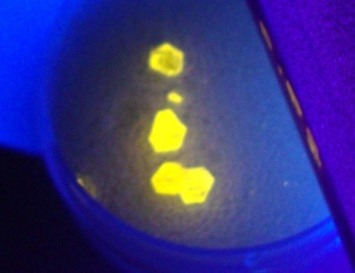
dr hab. Agata Kamińska, prof. IF PAN, prof. UKSW
(Instytut Fizyki PAN, Wydział Matematyczno-Przyrodniczy,
Uniwersytet Kardynała Stefana Wyszyńskiego w Warszawie)
Yellow luminescence of amphoteric dopants in GaN
Streszczenie
One of the most important milestones in the history of nitride research was the discovery of p-type doping related to magnesium by Hiroshi Amano in 1989, awarded with Nobel Prize in 2014 together with S. Nakamura and Isamu Nakasaki "for the invention of efficient blue light-emitting diodes which has enabled bright and energy-saving white light sources". Alongside magnesium, also beryllium had been taken into account as a natural candidate for such doping. However, so far no one realized Be-induced p-type conductivity. On the one hand, hybrid density functional calculations have shown that BeGa is a deeper acceptor than MgGa (550 vs. 260 meV ionization energy) and that this is the fundamental reason why Be p-type doping is ineffective [1]. On the other hand, it has been also suggested that with increasing doping level most of the beryllium is incorporated into the crystal in the interstitial instead of the substitutional position. In such a position Be acts as a donor not as an acceptor, exhibiting amphoteric character in GaN [2]. The optical studies revealed two luminescence bands; one at 3.38 eV and a second near 2.2 eV whose intensity increased with increasing Be content. A similar type of broadband yellow luminescence (YL) at about 2.3 eV has been observed in carbon-doped GaN. This luminescence has been related to the incorporation of C at the N site (CN) which acts as a deep acceptor with an ionization energy of 0.9 eV [3]. CN is predicted to be the dominant carbon-related defect in GaN over a wide range of concentrations. However, for high carbon concentrations experiments indicate that different configurations (CGa) need to be considered, indicating its amphoteric character [4], similarly like in the case of beryllium.
If we have an efficient and controllable source of YL in GaN, we could build a GaN-based monolithic white light-emitting diode. In order to shed more light on this issue, we performed high hydrostatic pressure studies of Be- and C-doped GaN crystals using the diamond anvil cell technique. In GaN:Be we observed a pressure-induced splitting of the YL line into two components: one strongly dependent on applied pressure and another whose pressure dependence was more modest. Based on calculations using the hybrid functional method we attribute the strongly-varying component to the beryllium-oxygen complex [5]. The second component of the YL possesses pressure behavior similar to that observed carbon-doped GaN, which we find consistent with the CN acceptor.
Additionally, at higher pressure, we observe the vanishing of YL in GaN:Be sample and a rapid increase in the luminescence intensity of the UV line. We explain this as the pressure-induced transformation of the Be-O complex from a highly localized state with large lattice relaxation to a delocalized state with limited lattice relaxation, also observed in the positron annihilation experiment as a function of temperature [6].
Link to video presentation
References:
[1] J. L. Lyons, A. Janotti and C. G. Van de Walle, Impact of Group-II Acceptors on the Electrical and Optical Properties of GaN, Jpn. J. Appl. Phys. 52, 08JJ04-1-5 (2013)
[2] J. Neugebauer and C. G. Van de Walle, Chemical trends for acceptor impurities in GaN, J. Appl. Phys. 85, 3003-3005 (1999)
[3] J. L. Lyons, A. Janotti, C. G. Van de Walle, Carbon impurities and the yellow luminescence in GaN, Appl. Phys. Lett. 97, 152108-1-3 (2010)
[4] F. Zimmermann, J. Beyer, C. Röder, F. C. Beyer, E. Richter, K. Irmscher, and J. Heitmann, Current status of carbon-related defect luminescence in GaN, Phys. Status Solidi B 218, 2100235-1-11 (2021)
[5] H. Teisseyre, J. L. Lyons, A. Kaminska, D. Jankowski, D. Jarosz, M. Bockowski, A. Suchocki, C. G. Van de Walle, Identification of yellow luminescence centers inBe-doped GaN through pressure-dependent studies, J. Phys. D Appl. Phys. 50, 22LT03-1-7 (2017)
[6] F. Tuomisto, V. Prozheeva, I. Makkonen, T. H. Myers, M. Bockowski and H. Teisseyre, Amphoteric Be in GaN: Experimental Evidence for Switching between Substitutional and Interstitial Lattice Sites, Phys. Rev. Lett. 119, 196404-1-5 (2017)
Lista terminów (Strona szczegółów wydarzenia)
- 24-01-2023 14:00 - 15:00




